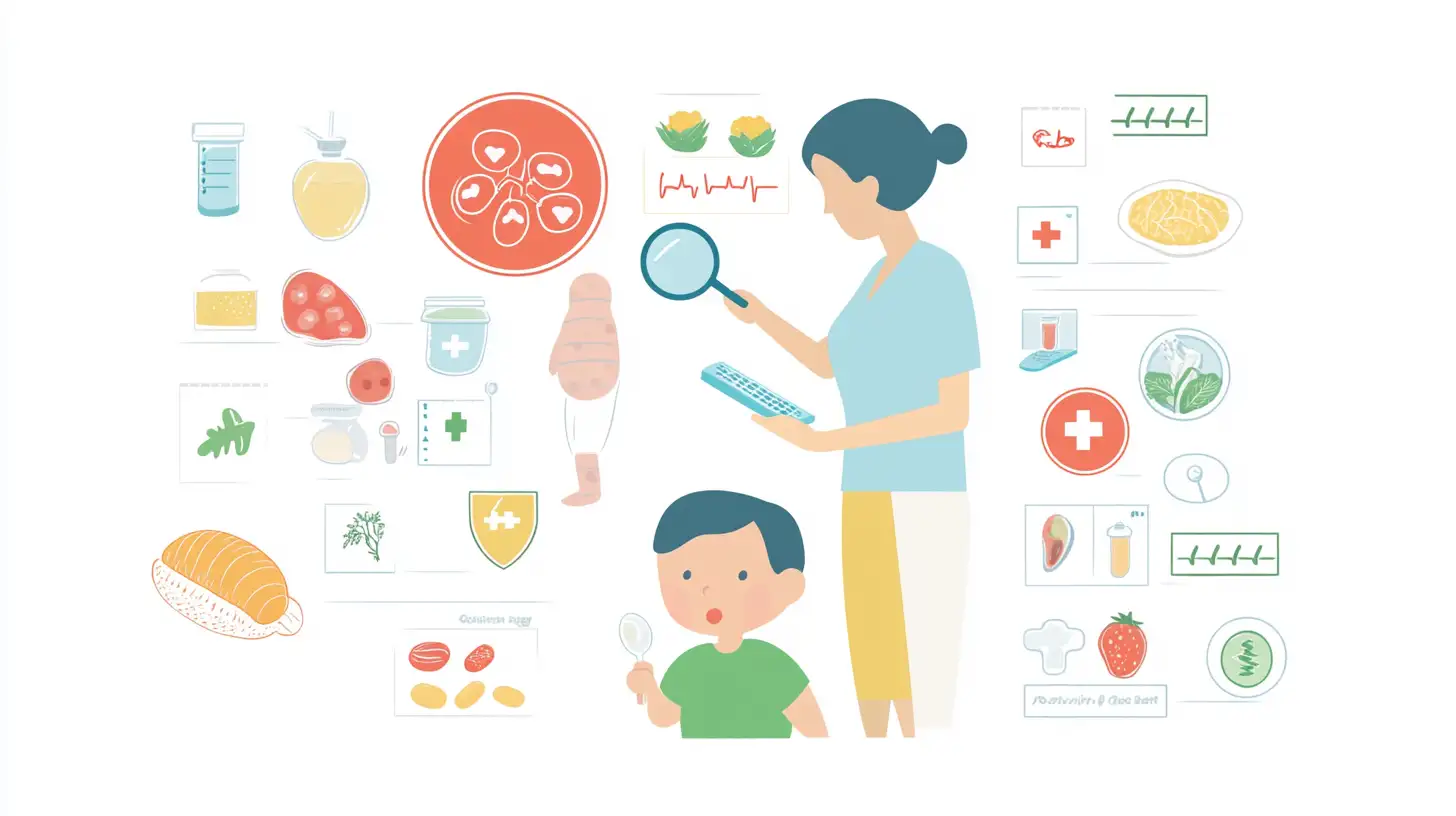Table of Contents
ToggleFirst Foods Without Fear: Why The Way You Introduce Allergens Matters More Than You Think
Have you ever found yourself staring at that jar of peanut butter, completely frozen with indecision? Maybe you’ve spent hours scrolling through parenting forums, desperately searching for the right way to introduce eggs or dairy to your little one. I get it. I’ve been there too, hovering over my daughter with my phone camera in one hand and the pediatrician on speed dial in the other, watching her take that first bite of almond butter toast like I was diffusing a bomb.
But here’s the thing – the more anxious we become about food allergies, the more overwhelming this whole journey starts to feel. The irony? That anxiety might actually be standing between you and the confidence you need to nourish your baby safely and effectively.
When my son was born, I thought I needed to have everything perfectly planned. I created spreadsheets tracking every potential allergen, timing them down to the minute, and obsessively photographing each reaction (or lack thereof). I was exhausted, he was confused, and mealtimes became this high-stakes drama that nobody was enjoying.
But then something changed. I learned a powerful truth about introducing allergens that transformed our feeding journey – and it might just change yours too. Because contrary to what you might think, success with allergen introduction isn’t about being perfect or controlling every variable. It’s about finding that sweet spot where knowledge meets confidence, where preparation meets flexibility.

The Science Has Changed (And That’s Actually Good News)
Let me first clear something up that might blow your mind if you’ve been getting advice from well-meaning grandparents. Remember when babies weren’t supposed to have peanuts until they were practically ready for kindergarten? Those days are gone, and with good reason.
Current research has completely flipped our understanding of allergen introduction. The groundbreaking LEAP study (Learning Early About Peanut Allergy) showed that early introduction of peanuts – between 4-11 months – actually reduced peanut allergy by a whopping 81% in high-risk infants. Can you believe that? All those years of delaying allergens might have actually increased allergy risks!
The American Academy of Pediatrics, the American Academy of Allergy, Asthma, and Immunology, and pretty much every major medical organization now agree: early introduction of allergenic foods is the way to go. This isn’t just a minor update to the guidelines; it’s a complete paradigm shift.
But here’s where many of us get stuck. We know the science has changed, but the fear remains. We understand intellectually that early introduction is beneficial, but emotionally? That’s a different story. The thought of watching our precious babies potentially react to a food is genuinely terrifying.
I remember sitting in my kitchen, a tiny bit of peanut butter diluted in breastmilk sitting in a bowl in front of me, and I just couldn’t do it. Not that day. The fear was too real. And if you’ve felt that way too, I want you to know something important: understanding the science matters, but honoring your journey as a parent matters too.

The Big 9 Allergens: Meeting Them On Your Terms
So let’s talk specifics. When we discuss allergenic foods, we’re typically referring to the Big 9 – the foods responsible for approximately 90% of all food allergies. These include:
- Milk
- Eggs
- Peanuts
- Tree nuts (like almonds, cashews, walnuts)
- Soy
- Wheat
- Fish
- Shellfish
- Sesame (the newest addition to this list)
Now before you start panicking about how to incorporate nine different allergens into your already chaotic feeding schedule, take a deep breath. This isn’t about checking boxes or racing through a list. It’s about thoughtful, intentional introduction that works for your family.
For my Caribbean family, some of these allergens were naturally part of our daily diet. Coconut (technically a tree nut allergen) was in our rice, fish was a regular dinner staple, and sesame appeared in many of our favorite dishes. But others, like peanuts and certain tree nuts, required more intentional planning.
The current recommendation is to begin introducing these foods when your baby is developmentally ready for solids (typically around 4-6 months) and to introduce them one at a time. But here’s the part that changed everything for me: once introduced and tolerated, these foods should remain regular parts of your child’s diet.
This is where I went wrong initially. I’d introduce peanuts, check it off my list, and then not offer them again for weeks. But consistency matters with allergen exposure. It’s not just about that first exposure – it’s about maintaining regular exposure to help the immune system recognize these foods as safe.

The Three-Day Rule: A Strategy That Actually Works
You’ve probably heard about the three-day rule – waiting three days between introducing new foods to watch for reactions. But let me share something that might change how you approach this.
The three-day rule is helpful, but it’s not sacred. Most allergic reactions, especially serious ones, occur within minutes to hours after exposure, not days later. Waiting three full days between every new food can unnecessarily prolong the introduction process and might actually make it harder to introduce a wide variety of foods during that critical window of opportunity.
What worked better for us was a modified approach. We’d introduce a new allergenic food in the morning (when pediatrician offices were open and we were fully alert), watch closely for 2-3 hours, and then, if all was well, we’d continue offering that food while introducing something new the next day or the day after.
I remember the morning we introduced eggs. I made a tiny bit of scrambled egg, just a teaspoon, and mixed it with breastmilk to thin the texture. My husband and I both cleared our schedules for the morning, had our phones charged and ready, and then… nothing happened. Our daughter happily gobbled it up and went about her day. The anticipation was far worse than the reality.
But the key here isn’t the specific timing – it’s creating a system that helps you feel confident while still making progress. Because here’s the truth: confidence is contagious. When you approach allergen introduction with calm confidence rather than visible fear, you’re creating a positive food environment for your child from day one.

Signs of Reaction: What You Actually Need to Watch For
This part is crucial, so let’s be super clear. Knowing the difference between a serious allergic reaction and normal baby messiness can save you countless hours of worry (and unnecessary trips to the emergency room).
Mild to moderate allergic symptoms include:
- Hives or welts (red, itchy, raised areas on the skin)
- Swelling of the lips, face, or eyes
- Itching or tingling of the mouth
- Abdominal pain or vomiting
- Eczema flare-up
Severe allergic symptoms (anaphylaxis) include:
- Difficult or noisy breathing
- Swelling of the tongue
- Swelling or tightness in the throat
- Difficulty talking or hoarse voice
- Wheeze or persistent cough
- Persistent dizziness or collapse
- Pale and floppy (in young children)
Here’s what’s not automatically an allergic reaction: a simple rash around the mouth (often just irritation from acidic foods), a single isolated hive that disappears quickly, normal baby spit-up, or loose stools after trying a new food (which can just be part of the digestive adjustment).
My son got what looked like hives after his first taste of strawberries. I nearly called an ambulance before realizing it was just the natural acidity of the fruit causing some redness around his mouth that disappeared within 15 minutes. Not every reaction is an allergic one.
But this isn’t about dismissing your concerns – it’s about giving you the tools to distinguish between normal reactions to new foods and true allergic responses that require attention. Because when you can confidently tell the difference, you free yourself from that constant background anxiety that makes feeding so stressful.

Making It Work: Practical Strategies From My Kitchen to Yours
Theory is helpful, but let’s get practical. How do you actually incorporate these allergens into your baby’s diet without losing your mind? Here are some real-world strategies that worked for our family:
Start with tiny amounts and gradually increase: Begin with a small smear of peanut butter diluted in breastmilk or formula, just a bite of scrambled egg, or a small spoonful of yogurt. If tolerated, gradually increase amounts over subsequent days.
Incorporate allergens into familiar foods: Add almond butter to oatmeal your baby already enjoys, mix a bit of tahini (sesame) into a familiar vegetable puree, or add finely ground walnuts to banana mash.
Create an allergen rotation schedule: This was a game-changer for us. We created a simple weekly rotation to ensure regular exposure to all major allergens. Mondays were egg days, Tuesdays featured yogurt and dairy, Wednesdays we’d incorporate a tree nut, and so on. This removed the daily decision fatigue about which allergens to offer.
Turn it into a family experience: Instead of making special baby food with allergens, adapt your family meals to be safe for baby too. Our Saturday morning peanut butter toast became a ritual where everyone participated, making allergen inclusion feel normal rather than medical.
Keep an allergen journal: A simple note on your phone tracking which allergens have been introduced, when, and any observations helps tremendously, especially during pediatrician visits. I used a template with three simple categories: Food introduced, Date, and Observations.
One of my favorite practical tips comes from my Caribbean heritage. We would make a simple coconut porridge with finely ground tree nuts mixed in – a single dish that incorporated multiple potential allergens while still being easy for baby to eat. Finding these multi-allergen recipes can simplify the whole process.
Moving Beyond Fear to Food Joy
The most valuable thing I’ve learned through this journey isn’t actually about allergens at all. It’s about the power of our approach and energy around food. When I stopped treating allergen introduction like a medical procedure and started approaching it as part of our joyful family food culture, everything changed.
The truth is, food is more than nutrition – it’s connection, culture, and joy. And when we bring fear to the table, our babies sense it. They absorb our anxiety along with their nutrients. But when we bring confidence and joy, they learn that food is a positive, exciting part of life.
Remember my friend who asked for my advice over dinner? She was so focused on getting it right that she’d completely lost sight of the joy in the journey. She was tracking every morsel, timing every bite, and turning mealtimes into medical events rather than family moments.
What she needed wasn’t another checklist or app – it was permission to trust herself, to find her confidence, and to bring joy back to the table. Because the real secret to successful allergen introduction isn’t found in the perfect schedule or method – it’s found in the balance between informed caution and confident joy.
And this brings me to the most important point of all: You’ve already won if you’re reading this article. You’ve shown up, you’ve sought information, and you’re doing your best to make informed choices for your child. That commitment alone puts you miles ahead.
Whether your baby has their first taste of peanut butter tomorrow or next month, whether you introduce eggs before wheat or vice versa, whether you follow a strict schedule or a more intuitive approach – what matters most is that you’re showing up with love and intention.
You are enough. Your efforts are enough. And together, we’re raising a generation of children who will hopefully have fewer food allergies and a healthier relationship with food than ever before.
I’d love to hear about your allergen introduction journey. What foods were easiest or most challenging to introduce? What strategies worked for your family? Share your experiences in the comments below, and remember – we’re all figuring this out together, one bite at a time.
- Picky Eating Prevention: Foundations in the First Year - October 17, 2025
- The Great Nursing Strike: Causes and Solutions - October 7, 2025
- DIY Baby Food: Equipment-Free Approaches - October 1, 2025



